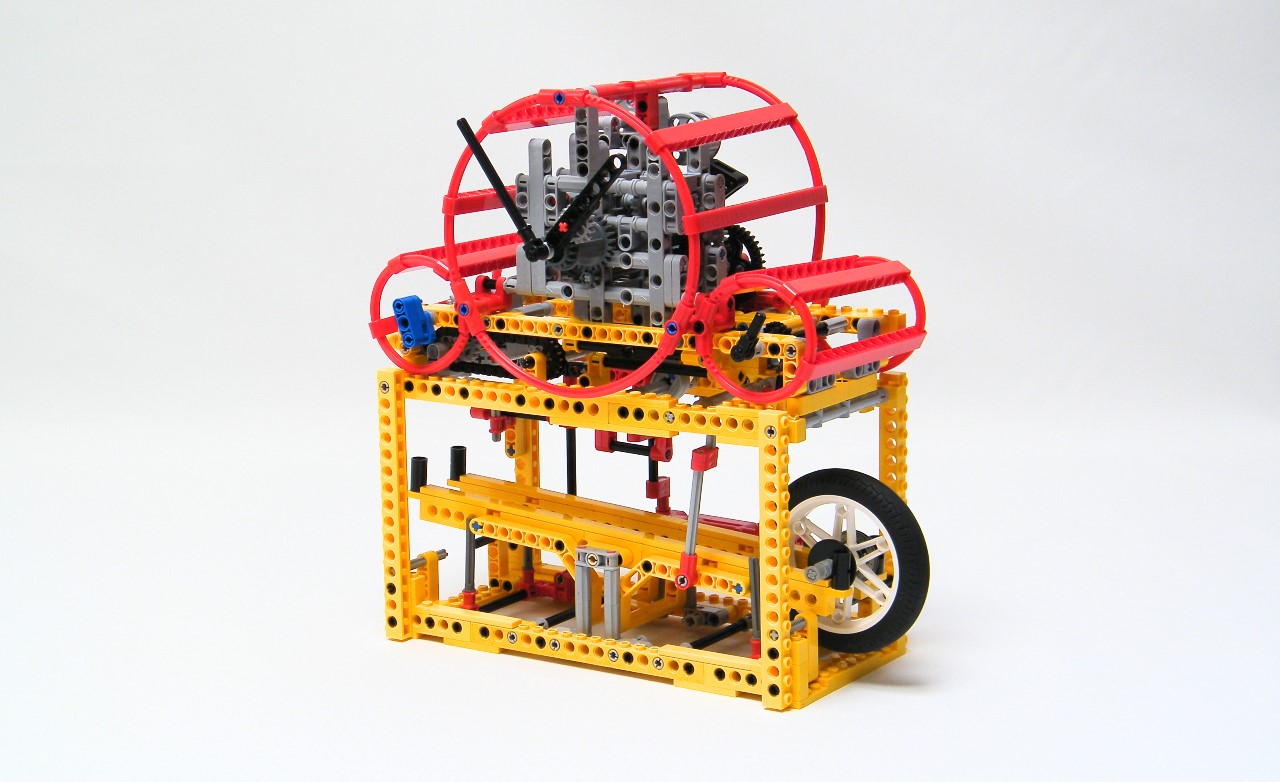A congreve clock with hour, minute and second hands, powered by a lego windup motor, featured a ring bell and a oscillating path.
I wanted for a while to build a clock powered by rolling mechanism instead of pendulum, that is why I have focused my researches on congreve clock. They are clocks powered by things which move on oscillated path, with linear of zig zag motion. My clock is mainly inspired by classic congreve clock but with a linear oscillating path
Functioning
The clock is based on a simple principle to rhythm the time : a inertia wheel rotates from each side by rolling on a oscillating path. Each time it comes at the end of the path, it pushes a lever which releases the mechanism which activates the oscillating path. It is mainly based on the principle on my first test for congreve clock (see on youtube).
The clock is powered by a single wind up motor from lego which can be wound by the small blue lever on the front at the left. On the main axle of the output of the motor is connected a 5L beam which is stopped in rotation by two rockers. A system of connecting rods and levers is connected to the two pushers in the end of each way of oscillating path. When the wheel comes at the end, it activates the release of the 5L beam which can so do 180° degree.
On this axle is connected a simple system of lever with connecting rod which goes back up or down the oscillating path, in this way, the movement is maintained until the wind up motor has enough energy (which correspond approximately at 15 minutes). The wheel, inclination and length of path have been chosen in order to have 10 seconds on each period. I have preferred to have a weighted wheel in order to have good period and inertia to activate the system but not too much for the motor which is pretty weak. This is a compromise between the weight for the period and the weight which the motor can handle.
The Clock System
Attached to that, is the clock system on the top of main mechanism. The clock is composed of three hands with gears between them. I have chosen to make the seconds hand in the small red circle on the right, and not in the big circle with the other hands. First of all because I had to fill the space inside this small circle to respect the original design of congreve clock. And secondly because the seconds hand moves each 10 seconds, that I found not appropriate for a big seconds hands (which have to move each seconds if it is placed on the center of the clock). Therefore, I have placed in the small circle has an indicator.
Concerning how is build the gearing inside the clock, it is mainly based on my cuckoo clock which is definitively a good base for working with clocks. You can see the previous work, here and here. Here is the ratio and gearing between hands :
- Seconds from the oscillating mechanism : Half Rotation Each 10 seconds, so 1/6 (10 seconds on 60) * 2 (a half rotation) = 1/3 made with 36t/12t
- Seconds / Minutes = A rotation seconds equal to 1/60 of minutes, equal to 1/24 * 0,4 made with Worm gear / 24t and 16t/40t equal to 60.
- Hours / minutes = A rotation of minutes, equal to 1/12 of hours, 12 = 2 * 2 * 3 made with 12t/24t + 12t/24t + 8t/24t (differential case).
For passing two axles in the same (hours and minutes), I have used a differential case powered on the 24t attached for the hours and the inside axle for the minutes.
To finish with the clock mechanism, you will have note that there are some hooks at the end of the clock, they are used for creating the ring bell mechanism. Each time the hand of minute makes a rotation (each hours), a lever moves the hook from the left to the right and after releases causes the knocking together which sound like a bell because of the shape and material : ribbed and metal. This is a purely lego bell.
Design
The design is inspired by traditional congreve clock with three circular shapes which overhang the yellow frame and oscillating mechanism. For viewing convenience I have made an openable mechanism. By rotating the small lime green lever behind, it releases the upper structure of the clock which is attached to the right panel. The building is made in order to keep working the oscillating mechanism even if the clock is opened. Of course, time will not work but oscillating mechanism do.
Autonomy and Accuracy
The autonomy is rather good for a oscillating windup powered clock : 15 minutes with a total winding of the motor. More autonomy is possible with a more powerful motor to have a bigger wheel or less reduction between the motor and the axle which drives the oscillating path. Here is a compromise based on capabilities of the motor.
Concerning the accuracy, this is not very accurate, because of the principle of oscillating path and slipping wheel. Sometimes, the wheel has not the same friction against the end of the path and sometime it doesn’t restart as fast as the other end. Anyway, the wheel is quite big therefore the accuracy is not too bad : 1seconds / 2-3 minutes.
Conclusion
Building a congreve clock is such a hard exercise. Because I had to conciliated the autonomy of the clock with the inertia of moving parts and efforts needed to move it. The starting point was of course the system of oscillating path with levers and connecting rods system. After that, I had to make it reliable and constant by adjusting carefully the period of 10 seconds. Then, I have made the system of wind up motor and after the clock system with the gearing which took me many time to place the gearing in the frame. At the end, I had some place at the bottom of the clock, that is why I decided to come up with a ring bell mechanism, which was easy to implement.
Videos and pictures
More than thousand words, the video explains all mechanisms in this clock :




(22) Comments
This is really cool! I’ve tried to build just the oscillating mechanism, but no luck yet. But now that I see your version, I totally understand it and can build it now.
P.S.
I’m eleven.
Hello, unfortunately, all I have is on my website.
hello nico i would like to know if there is a youtube video from you or someone else who has built it i can just watch the video and build it without instructions. thank you
Hello, sorry there is not building instructions neither partlist, so hard to rebuild !
Hi , i want make one , but How i can do ?
Sorry no !
Hi .
Do you have instruction and part list ?
Thanks
Unfortunately no because it is already dismantled.
will you ever make building instructions for your Congreve clock
it is probably because of used axle or bad bracing of the axle. The transmission has to be as smooth as possible, and I did not use any oil or grease 🙂
Update: Solved the issue by removing the second handle’s connection to the back. Now it works fine. I like it!
Hello! I built this clock, but unfortunately it seems that the normal wind-up motor is too weak to actuate the clockwork. Did you apply some special oil onto the mechanism or is my wind-up motor simply too weak?
Thank you for your response
Hi! I am Choi in S.Korea. I have a museum. The museum name is ‘Time Museum’. You can see my museum at http://www.jdjmuseum.com.
This museum is displaying most unique and interesting clocks in the world. So, I would like to display your lego congreve clock. But I can not build it. Even if I have read your policy, Actually I want to buy the clock. Most visitors of my museum will enjoy your work. I will wait a good news from you. Best regards. Choi
Sorry I has been dismantled. Regards.
could you please leave building instructions for this clock please.
Hello, sorry, not bill of material and not for sale ! Regards.
Evening Nicolas,
Are the instructions and parts list for sale for the Congreve Clock or cuckoo clock? I’ve tried looking but they don’t appear to be available.
They look really fun!
Thanks
Hi! I know it’s been a while since you’ve uploaded this but can you please make a parts list / instructions? Thanks!
Nicely executed! Maybe if the rocker was triggered earlier the clock wouldn’t lose as much energy to the spin of the weight at the end of the oscillator.
Hello Nico,
may you use another type of lego windupmotor to achieve higher autonomy and accuracity.At the moment i can remember the actual name but i remember the one which is quite similar to the old 9v motor was quite strong and enduring
greets
Tjark
Compliquer et magnifique en même temps, comme toujours d’ailleurs.
Les horloges occupent toute tes pensez, ça devient une obsession ou juste une très grande passion, en tout cas bravo cette construction est une vraie inspiration.
This is some fine work. The precision of 1 second over 2 minutes is pretty good – I remember having an old wind-up watch as a kid that my grandfather gave me and it was always off by a few minutes at the end of the day. Congratulations!
Comments are closed.